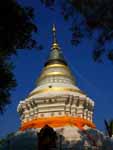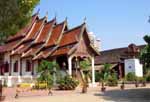Wat Gate
 The temple's imposing chedi. |
You won't find it in any of the current popular guidebooks, but Wat Gate (or more properly Wat Gatekaram) is a temple we think is well worth a visit. Located on the east bank of the Ping River, across from Chiang Mai's city center, the temple is now at the center of a very rich historical district full of designer boutiques and some of Chiang Mai's most pleasant restaurants.
The origins of the temple are a bit murky, but it now seems to be agreed that it was founded around 1428, about 150 years after Chiang Mai's founding. The banks of the river in front of the temple served as the 'port' of Chiang Mai up until the railroad came to town early in the twentieth century. Since Chiang Mai was the center for teak and other commodities, as well as the main gateway to move goods to the southern provinces, the district became the center for foreigners coming to Chiang Mai to trade. This explains the many building styles along Charoen Rat Road around Wat Gate, reflecting Chinese, Portuguese and Indian influences.
At the center of the temple is the large chedi, capped by an elegant bell-shaped finial covered in bronze tiles oxidized to various shades of blue and green. The corners of the chedi are guarded by imposing garudas decorated with multi-colored mirrored tiles.
 The temple's ordination hall (ubosot), with its unusual sculpted exterior. |
 The rare five-gabled prayer hall (wiharn). |
Beyond the wiharn is an old building now housing the Wat Gate Museum. Its a very interesting eclectic collection that is one of our favorites.
http://thailandforvisitors.com/north/chiangmai/cm-temps.html
No comments:
Post a Comment